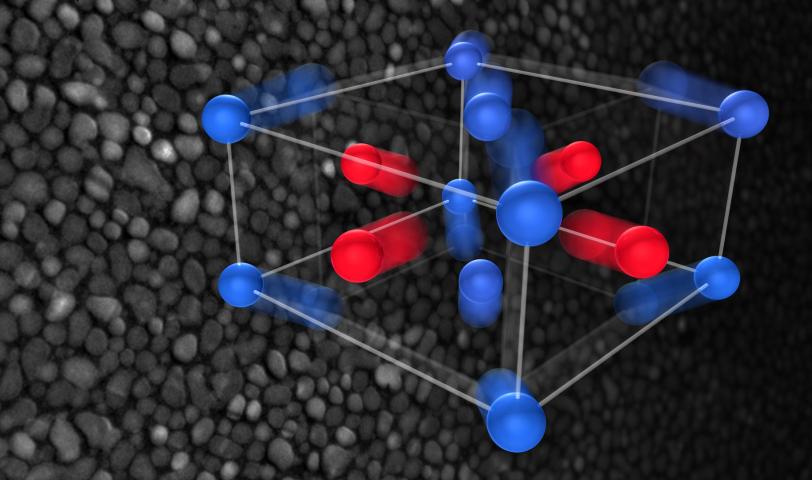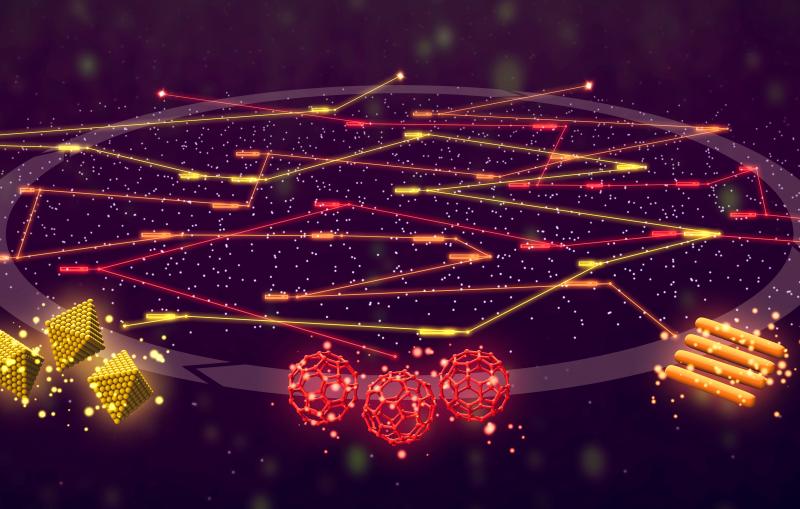Scientists Catch Light Squeezing and Stretching Next-Gen Data Storage Material
Combining X-ray and electron data from two cutting-edge SLAC instruments, researchers observe the rapid atomic response of iron-platinum nanoparticles to light, which could help control future magnetic data storage devices.
By Manuel Gnida
Scientists at the Department of Energy’s SLAC National Accelerator Laboratory have seen for the first time how atoms in iron-platinum nanoparticles – a next-generation material for magnetic data storage devices – respond extremely rapidly to brief laser flashes. Understanding these fundamental motions could potentially lead to new ways of manipulating and controlling such devices with light.
Combining snapshots from two world-leading ultrafast atomic-resolution “cameras” at SLAC – the Linac Coherent Light Source (LCLS) X-ray laser and an apparatus for ultrafast electron diffraction (UED) – the team showed that the laser flashes demagnetized the iron-platinum particles within less than a trillionth of a second, causing atoms in the material to move closer together in one direction and move further apart in another.
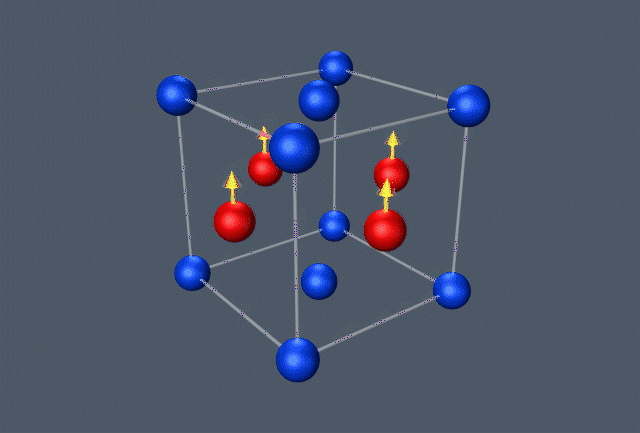
The results also provide the first atomic-level description of the mechanical strain, known as magnetostriction, occurring in magnetic materials when the magnetization is changed. The phenomenon manifests itself in many ways, including the electric hum of transformers. Before the study, published today in Nature Communications, researchers had assumed that these structural changes happen relatively slowly. However, the new data suggest that ultrafast processes could play an important role.
“Previous models of the properties of iron-platinum nanoparticles did not consider these extremely fast and fundamental atomic motions,” says Hermann Dürr, the study’s principal investigator from the Stanford Institute for Materials and Energy Sciences (SIMES), which is jointly operated by SLAC and Stanford. “Although we don’t yet understand the full ramifications of these processes, including them in our calculations could open up new pathways for the development of future data storage technologies.”
Pushing the Limits of Magnetic Data Storage
Magnetic storage devices are widely used to record information produced in virtually all areas of our digital world, and they are believed to remain crucial data storage solutions for the foreseeable future. Faced with ever growing amounts of global data volumes, hardware engineers are aiming to maximize the density with which these media can store information.
However, current technologies are coming close to their technical limits. Today’s hard disk drives, for example, can reach storage densities of several hundred billion bits per square inch, and similar future devices aren’t expected to exceed much more than a trillion bits per square inch. New developments are required to take magnetic data storage to the next level.
“A very promising approach that could take us there is heat-assisted magnetic recording in hard drives using nanosized grains of materials like iron-platinum,” says Eric Fullerton, director of the Center for Memory and Recording Research at the University of California, San Diego, and a co-author of the new study. “In this method, the information is encoded with a nanofocused laser and a magnetic field, or possibly even a laser alone, that switch the magnetization of the nanoparticles. These next-generation drives, which can have much larger storage densities, are already being tested in industry and could soon become commercially available.”
The SLAC study looked into an important facet of this technology – the interaction of laser light with iron-platinum nanoparticles.
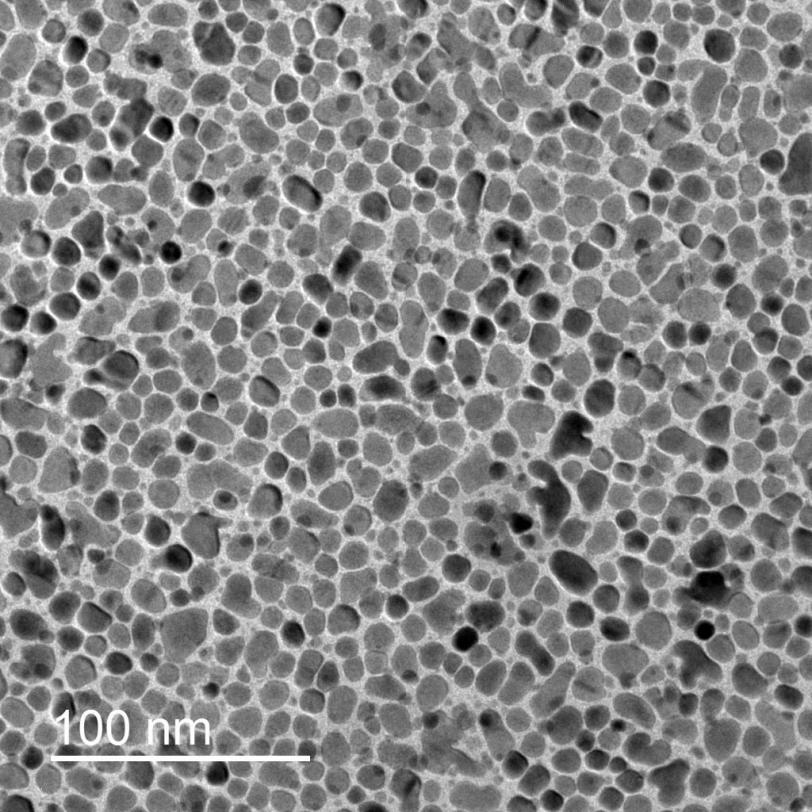
Combining X-Ray and Electron Vision
The researchers first took the nanoparticles, which were about 50 atoms in diameter, to LCLS, where they shone a brief optical laser pulse onto them. With LCLS’s ultrabright femtosecond X-ray flashes they were able to follow how the laser light changed the magnetization of the material – from completely magnetized to largely demagnetized. One femtosecond is a millionth of a billionth of a second.
They repeated the experiment using the UED instrument at SLAC’s Accelerator Structure Test Area (ASTA), in which a pulsed beam of very energetic electrons probed the samples. With this method, the scientists made a stop-motion movie of how atoms in the nanoparticles moved after being hit by laser light.
“Only the combination of both methods allowed us to see the full picture of the ultrafast atomic response to laser light,” says Alexander Reid, the study’s lead author from SIMES and LCLS. “The laser pulse alters the magnetization in the material, which, in turn, drives structural changes and causes mechanical strain.”
Xijie Wang, head of SLAC’s UED initiative, says, “This study demonstrates how powerful the two methods are together. The high-energy electron beam was absolutely crucial in the determination of the 3-D atomic motions, and without X-rays we wouldn’t have been able to link these motions to the material’s magnetic behavior.”
In addition to SLAC and Stanford researchers, the collaboration included scientists from the Czech Republic, Germany, Japan, Sweden, The Netherlands, as well as several U.S. institutions. Part of this study was supported by the DOE Office of Science and the Laboratory Directed Research and Development (LDRD) Program. LCLS is a DOE Office of Science user facility.
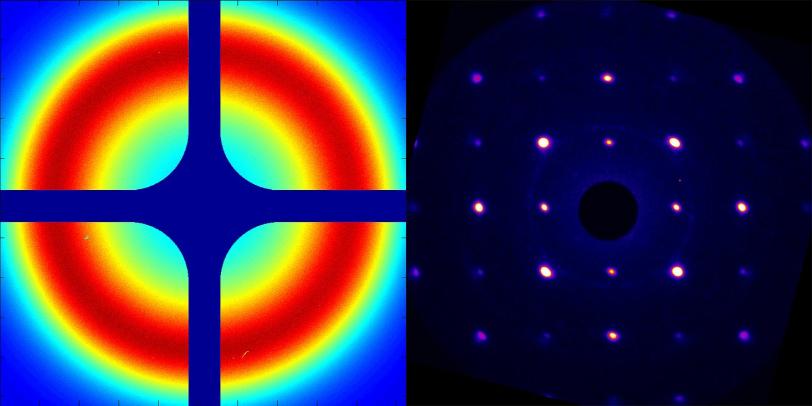
Citation: A. H. Reid et al., Nature Communications, 26 January 2018 (10.1038/s41467-017-02730-7)
For questions or comments, contact the SLAC Office of Communications at communications@slac.stanford.edu.
SLAC is a multi-program laboratory exploring frontier questions in photon science, astrophysics, particle physics and accelerator research. Located in Menlo Park, Calif., SLAC is operated by Stanford University for the U.S. Department of Energy's Office of Science.
SLAC National Accelerator Laboratory is supported by the Office of Science of the U.S. Department of Energy. The Office of Science is the single largest supporter of basic research in the physical sciences in the United States, and is working to address some of the most pressing challenges of our time. For more information, please visit science.energy.gov.
